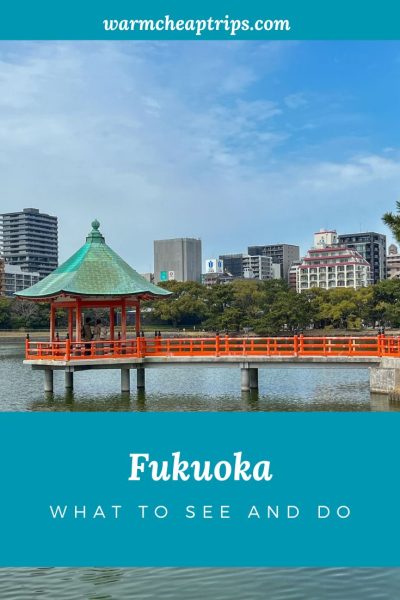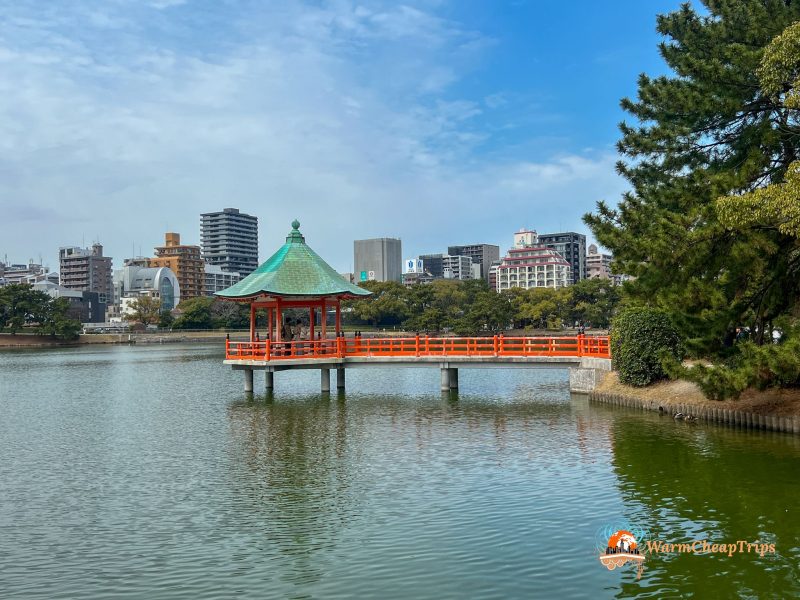Included among Lonely Planet’s Best in Travel 2024 for the culinary category, Fukuoka is the gateway to Kyushu, the southern island of Japan. A vibrant and modern city, where the unmistakable smell of ramen hits you as soon as you turn the corner.
I’ll be honest: as a city, Fukuoka doesn’t get me so much. It feels like a transit place, but without that blending of cultures and influences that port cities usually have—like nearby Nagasaki. A city of more than one million residents, the largest in Kyushu, yet it doesn’t have the energy and neon lights of Tokyo and Osaka, nor the elegance and refinement of Kyoto or Kanazawa. Fukuoka is, for me, a somewhat anonymous city that is however trying to carve out its own space as a stop to include on a trip to Japan.
And indeed, Fukuoka is a stop that absolutely makes sense. It’s the access city to the Kyushu region, the final stop of the Shinkansen line that connects Tokyo to Osaka and continues through Hiroshima before ending in Hakata, the main station of Fukuoka. But it’s also home to an international airport located about ten minutes away by subway, where many international airlines land, such as Cathay Pacific, which connects Fukuoka to Asia, to Europe via connecting flights, and to nearby Korea: Busan is only one hour away by plane, while a flight to Tokyo takes one and a half hours! And you can also reach Busan by ferry, including overnight ferries, connecting Japan and South Korea—making Fukuoka an almost essential stop for those planning a combined trip to these two East Asian countries.
Fukuoka is a recent city, developed and grown in the past decades, with many Japanese choosing to move to this “new city” after the Tōhoku earthquake in 2011, partly due to its lower seismic risk. In short, Fukuoka is a city still in progress, attracting people also for its quality of life—wider spaces, squares, canals, and plenty of greenery—while still offering all the conveniences and entertainment of a major urban center.


Why visit Fukuoka
Fukuoka doesn’t really have iconic must-see places; its spirit lies more in the liveliness of its people gathering to eat together at the yatai, in the walks along the waterways that cross the city, and in the buzzing youth crowding the many shopping centers. The current Fukuoka actually dates only to 1889, when the castle and samurai district, called Fukuoka, merged with the district of Hakata, inhabited by merchants and craftsmen, which is where the Shinkansen station is located today.
It’s not an overly touristy city—although very visited by Chinese and Koreans due to proximity—but full of life, where you can observe Japanese city life without feeling overwhelmed. Fukuoka also hosts one of the six major sumo tournaments, the November tournament, although getting independent access tickets is not easy here either.
The two main hubs are: the Nakasu area, where Hakata Station and the old merchants’ district are located, and the Tenjin area, from where trains and buses depart and arrive for other Kyushu destinations, plus the Daimyo area, the gathering spot for young people, full of vintage shops, independent boutiques, trendy cafés, and traditional bars.
If you’re looking for a more relaxed city, yet modern and vibrant at the same time, you’ll love wandering around Fukuoka and slowly discovering its different souls.
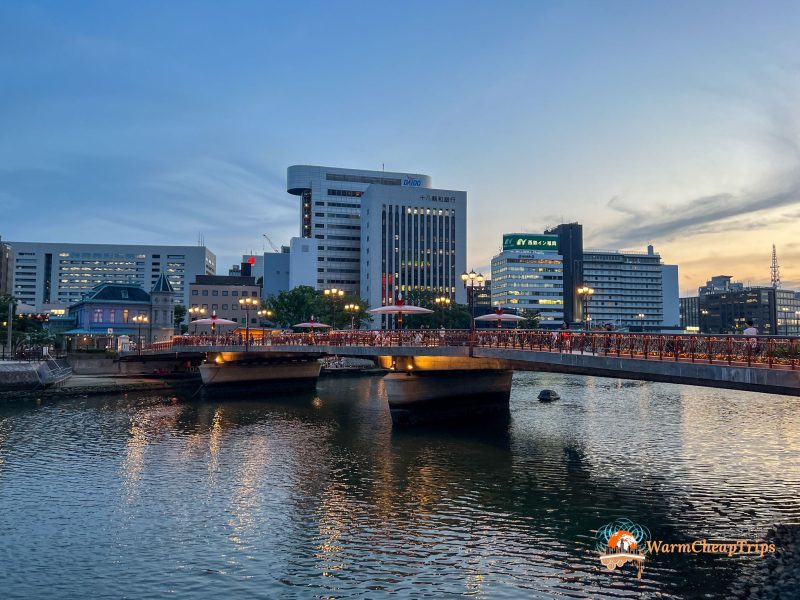

For food lovers: ramen, mentaiko, and yatai
Tonkotsu ramen is one of the most beloved types of ramen in Japan, and if you love this dish, a stop here is mandatory. Intense, rich, full-bodied…made from pork bones and incredibly creamy, it was born right here, and you’ll often smell its strong aroma wafting through the streets. Here you’ll find the main shop of the famous Ichiran ramen (there are three locations in total), but you can easily skip the long line and dive into any local ramen-ya—you’ll enjoy one just as delicious.
Fukuoka is also the main production center of mentaiko, a type of spicy roe, very popular and widely used in Japanese cuisine. People here are literally crazy about it, and you’ll find it everywhere, both as a souvenir or to eat. There is even a renowned restaurant serving only mentaiko-based dishes—Ganso Hakata Mentaiko—and you can also take a factory tour at the Haku Haku Museum.
But the best culinary experience—and the reason why the city was mentioned by Lonely Planet—are the yatai, the iconic food stalls that appear every night along the sidewalks in Nakasu and Tenjin. These tiny restaurants on wheels cannot open before 5pm, and it is only at that time, every evening except Sunday, that these stalls roll in, open up, and are ready to feed and serve patrons late into the night. Ramen, gyoza, and yakitori are the staples, but you’ll also find creative stalls serving pasta or French cuisine, always accompanied by alcohol—the best Japanese tradition for socializing. At yatai you sit next to strangers, all squeezed around the master and onesan who cook, chatting and socializing in a cheerful and relaxed atmosphere.
In Nakasu along the canal there are many, side by side, and the atmosphere is definitely more lively—but also more touristy, with higher prices and mediocre quality. I recommend heading to the Tenjin area, where locals prefer to gather.
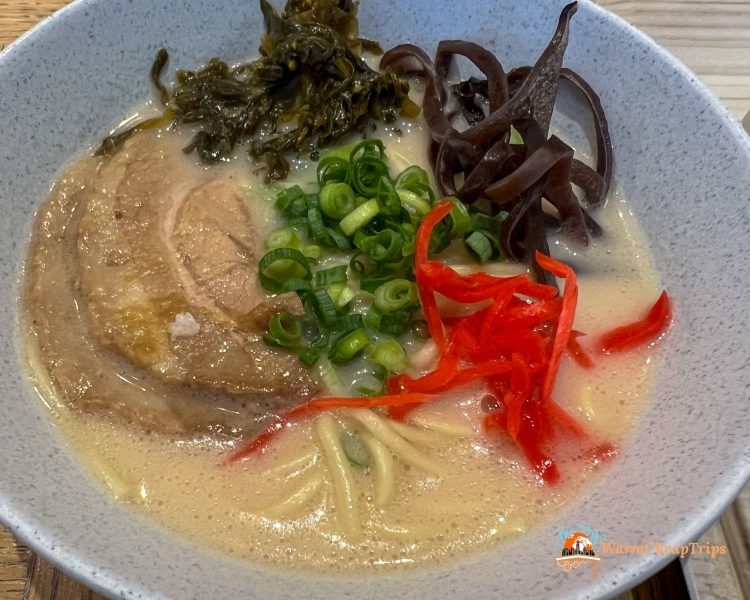

For tradition lovers: temples and gardens
One of the best aspects of Fukuoka is that it’s an airy city with lots of open “space,” especially compared to other Japanese cities. The Fukuoka Castle Ruins Park offers a large green lawn where you can relax, and it’s particularly scenic during seasonal blooms—plum blossoms in late February, cherry blossoms in late March, and wisteria in May. The castle itself was destroyed, and only sections of its walls remain, but light-up events and installations are often organized where the main tower once stood.
Beside the castle ruins is Ohori Park, with its pond crossed by a narrow path where you can stroll under the pine forest and take a picture at the small but photogenic Ukimi-do Pavilion. Along the lakeside, you’ll also find the Fukuoka Art Museum (there are several art museums in the city) and the Japanese Garden, which requires an entrance fee and is closed on Mondays.
Speaking of gardens, I also recommend Yusentei Park, a small but very charming Japanese garden in a quiet area a bit outside the city center, rarely mentioned among things to see in Fukuoka, but really lovely and peaceful. 200 yen, and only me and a Japanese family on a Saturday morning!


In July, Fukuoka hosts the very colorful Hakata Gion Yamakasa, an UNESCO intangible heritage festival, with enormous colorful floats pulled through the streets. During the rest of the year, two of these over-two-ton floats can be admired in the Hakata Old Town and at the Kushida Shrine, the oldest in the city and dedicated to the festival.
Across the city, you’ll also find other temples such as Sumiyoshi Shrine, one of the oldest in Kyushu, Tochoji Temple, featuring the 16-meter Senju Kannon statue, the second largest in Japan, and Ebisu Temple, dedicated to the protector of merchants and fishermen.
I also point out the unique Nakatsukasa Magotaro Inari Shrine, which during the day looks like a regular Inari shrine with red torii gates, but when night falls the neon lights turn on and the shrine transforms into a “Cyber Shrine”!
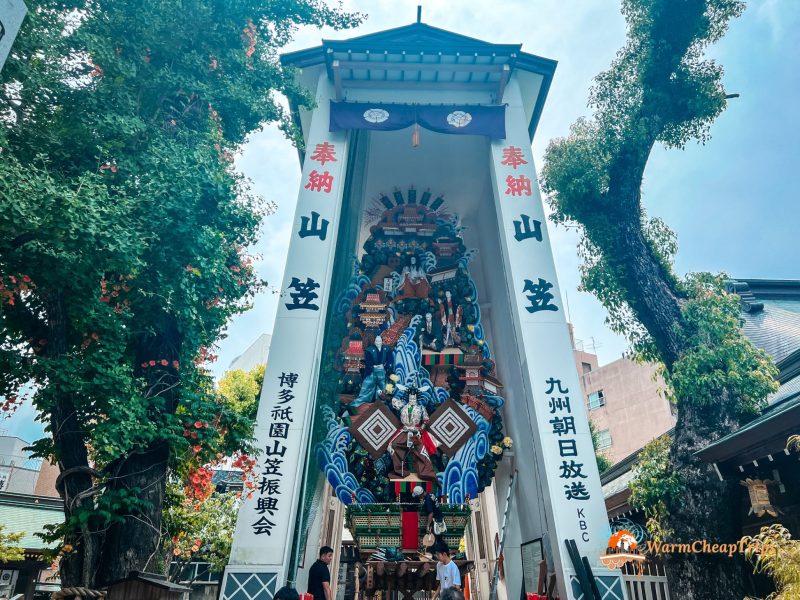

For shopping lovers: unique shopping malls
Okay, maybe shopping malls aren’t the main reason to travel to Japan—but remember that it’s inside them that you’ll find Pokémon Centers, Nintendo stores, and Ghibli and Hello Kitty shops. And while in Tokyo, Kyoto, and Osaka these stores are usually super crowded, in Fukuoka you can browse merchandise calmly without being crushed by people.
Among the main malls, mention must be made of the huge Canal City, almost a city within a city, also hosting convention centers and hotels in addition to many shops and restaurants. The central area includes a pool with fountains offering a dancing water show at certain times, especially beautiful at night.
Another honorable mention goes to LalaPort, just outside the center, where you’ll find the largest Gundam statue in Japan. Absolutely unmissable for anime and manga lovers.


Day trips from Fukuoka
From Fukuoka, it’s easy to reach many other Kyushu cities thanks to fast Shinkansen connections, making it a perfect base even for travelers who prefer not to change hotels often and want to visit Nagasaki, Beppu, or Kumamoto as day trips. Besides these destinations—which I think deserve more time—you can also do half-day trips nearby.
Sasaguri and the Reclining Buddha at Nanzo-in Temple
With only a 30-minute train ride, you can reach one of the most photographed temples in all of Fukuoka: Nanzo-in and its huge reclining Buddha. Although reclining Buddhas are common in Southeast Asia, they are rare in Japan, and this statue’s particular shape is due to the fact that it was built to enshrine sacred Buddha ashes donated by the Myanmar Buddhist Congress after Japan provided medical aid to the country for several years.
The statue is 41 meters long and 11 meters high—the same measurements as the Statue of Liberty—and is the world’s largest bronze reclining Buddha. The statue is located in a specific area of the temple, which recently became paid for non-residents of Japan, unfortunately necessary to control the hordes of tourists, especially Asian tourists, who came to this sacred place to film TikTok dances… It is also the only place where proper clothing and covering tattoos are explicitly required; cloths are available at the entrance.
In Sasaguri, where Nanzo-in stands, you’ll also find the Kyushu University Forest, including the particular Waterside Forest, where trees grow out of the water. The forest walk to get there is easy and pleasant and takes about an hour and a half. It’s on the same train line that connects Nanzo-in to Hakata Station, about 2 km from Kadomatsu Station; buses also connect it to Tenjin Station in about 30 minutes.
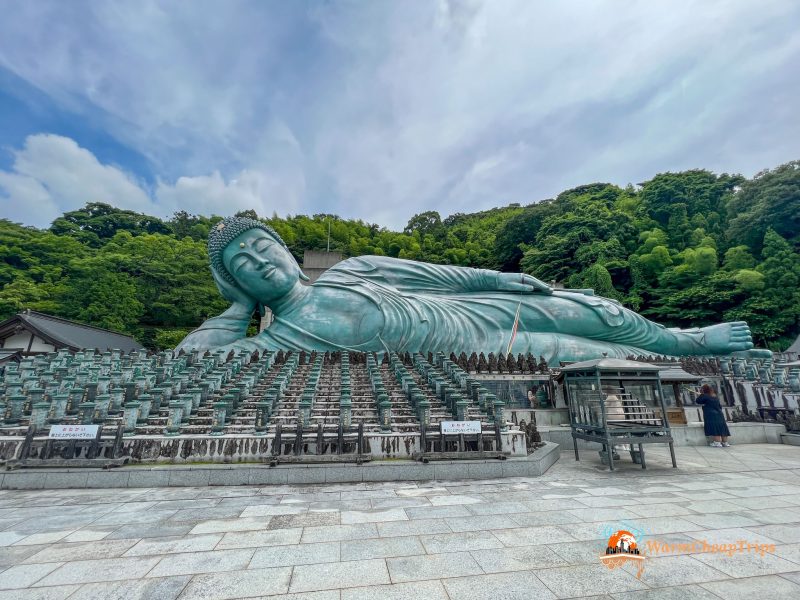

Dazaifu & Yanagawa
I remember years ago speaking with a girl from Fukuoka, and when I asked what there was to see in her city she replied: “Nothing special, just the Dazaifu Shrine.” Actually, Dazaifu Tenmangu Shrine is the main shrine dedicated to the scholar Sugawara-no-Michizane, and all other Tenmangu shrines in Japan belong to it. It is a large shrine with red bridges and a splendid plum garden blooming with wonderfully scented pink flowers between late February and early March. The complex is large and extremely pleasant to stroll through, both the temple area and the approach street filled with souvenir and street food shops, where you must try umegamochi. You can reach Dazaifu easily with a direct train from Tenjin Station, and at certain times you can take the Tabito train, with cars designed to represent the four seasons of Dazaifu.
Visiting Dazaifu takes only a few hours, so it is usually combined with Yanagawa, a charming town of historic merchant houses crossed by canals where you can take a boat ride. The interesting thing is that there’s a super-low bridge below which the boats pass, requiring passengers to practically lie flat to get through…while tourists crouch inside the boat, the boatman uses a very unusual technique: he pushes the boat under the bridge, walks across the road above, and then jumps back into the boat with a powerful leap!
There are seven companies offering boat tours; two depart near the station and last about an hour and a half but do not pass under this bridge. If you reach the historic district, you can choose the 30-minute tour (1,000 yen) and the companies Yanagawa Cruise Marue Sightseeing, Hakushu Tourism, and Castle Gate Tourist are the three I saw passing under that bridge.
Boats usually depart every 30 minutes or when enough passengers have boarded. While sailing, the boatman explains the history of Yanagawa in Japanese, but some companies have English-speaking boatmen, such as Castle Gate Tourist.
Not every boatman performs the jump… sometimes it’s not possible because there are too few people and not enough weight on the boat, or the boatman doesn’t feel confident, or traffic prevents timing the jump correctly… as always, it requires some luck, but the boat ride is still worth it.
For Yanagawa too there is a special train at certain times—the Suito train, with a special design honoring the samurai Tachibana clan who controlled the Yanagawa domain.


Itoshima
Unfortunately, I haven’t yet had the chance to personally visit the Itoshima peninsula, but it’s definitely on my wishlist for next time. It’s best to have a car to explore this nature-rich area, but you can still reach the coastal area of Sakurai Futamigaura by public transportation, where you’ll find the white torii gate rising out of the water and the two “married rocks” tied with a sacred rope. This coastal area, with white sand and crystal-clear sea, is particularly scenic both during the day—with many cafés and Instagrammable spots—and also at sunset.
For those with a full day available, you can also reach Keya no Oto, a rugged basalt coastline, accessible through the “Totoro Forest” with an intertwining tunnel of trees and roots reminiscent of the one in the famous Ghibli film.
Where to stay in Fukuoka
Having visited Fukuoka several times for work, I’ve had the chance to see and try various hotels in the city. The two main areas to stay are around Hakata/Nakasu Station and the Tenjin area. Personally, I prefer Tenjin—more local and quiet, yet full of restaurants and shops—but if you plan to travel often, especially using the Shinkansen, the Hakata area is more convenient.
It’s easy to move between the two areas using the super convenient subway, or with a pleasant 30-minute walk, so as long as you choose a hotel in either zone, you won’t have problems.
In the Hakata/Nakasu area, I recommend Hotel Vista Fukuoka, which I personally tried and loved. Very well-organized room and public hot bath available. In my opinion, the moderate room is better than the comfort because even though the bathroom is compact, there is more space for suitcases in the main room. Highly recommended breakfast with local products and Fukuoka specialties. Another great option is Tokyu Stay Hakata , often the best budget choice near Hakata Station, with fairly spacious rooms and modern bathrooms.
I also tried Washington Hotel Canal City, very convenient because the elevator leads directly to the ground floor of Canal City and I could watch the fountain show from my window—but the room is really small with limited luggage space (if you choose it, go for at least a twin). Also, check-out is until 11, but if you register as a free member you get a complimentary bottle of water and late check-out at noon. I do not recommend The Lively Fukuoka, which looks super cool from the lobby and entrance but then has truly TINY rooms even by Japanese standards.
In the Tenjin area I recommend Best western Fukuoka Tenjin Minami, excellent value for money, with enough space in the room and a modern compact bathroom, but if you have a little more budget choose the brand-new The Gate Fukuoka, opened in spring 2025 and really beautiful, with spacious rooms, separate shower (not the cursed curtain!), and a beautiful terrace overlooking the port.
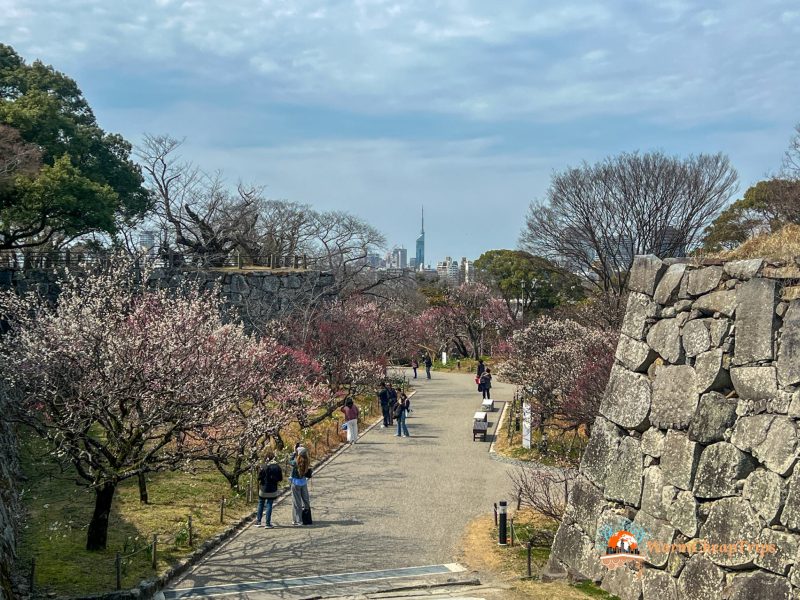

In short, Fukuoka is a city to experience, to use as a base to explore the surrounding areas and take day trips, returning to enjoy its lively and cheerful evenings. You might also consider booking a guided tour, and remember that by downloading the GetYourGuide app and entering the code WARMCHEAPTRIPS5 you’ll also receive a 5% discount.
Did you find this article useful? Buy me a coffee 🙂
